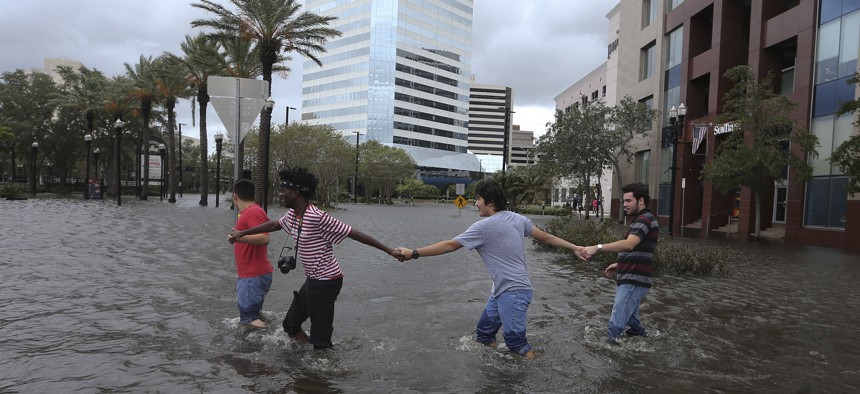Florida’s Largest City Faces ‘Trifecta’ of Problems as Irma Exits the State

Four people link arms as they explore the flooded Jacksonville Landing in the wake Hurricane Irma on Monday, Sept. 11, 2017, in Jacksonville, Fla. John Bazemore / AP Photo
The hurricane swamped Jacksonville with flooding said to be the worst in 100 years.
With Hurricane Irma, much of the attention has been focused on Florida’s southwestern coast, where storm surge and winds were the strongest closest to where the eye came ashore, the weakened storm had an unanticipated surprise for Jacksonville, around 350 miles to the north near the state’s border with Georgia.
Due to the hurricane’s massive size, both the state’s Gulf and Atlantic coasts were battered by storm surge as Irma headed north into Georgia and Alabama on Monday.
Jacksonville, according to the Florida Times Union, is facing an unlucky “trifecta of factors” that will keep water levels high along the St. Johns River and elsewhere in the area: Storm surge from the Atlantic Ocean is pushing up the St. Johns River as excessive rainfall is trying to drain into the river, all exacerbated by strong lunar tide cycles.
That means local water levels will remain high, especially in downtown Jacksonville and low-lying areas adjacent to the river, which is Florida’s longest.
The Los Angeles Times reported Monday that the flooding in Jacksonville is the worst the city has seen in 100 years.
The region had already seen significant rainfall before Irma moved into Florida, the Florida Times Union reported. A local hospital in the Riverside neighborhood evacuated patients due to the high water. At one point, Jackson Fire and Rescue received 600 calls for rescue assistance over a six-hour period.
Areas along the St. Johns River were under a flash flood warning for much of Monday.
The coasts of Georgia and South Carolina also saw high storm surge on Monday associated with Hurricane Irma, with Savannah and Charleston seeing high water levels overtake low-lying areas.
Michael Grass is Executive Editor of Government Executive’s Route Fifty and is based in Seattle.
NEXT STORY: As Hurricane Irma Heads North, Officials Urge Floridians to Stay Put






